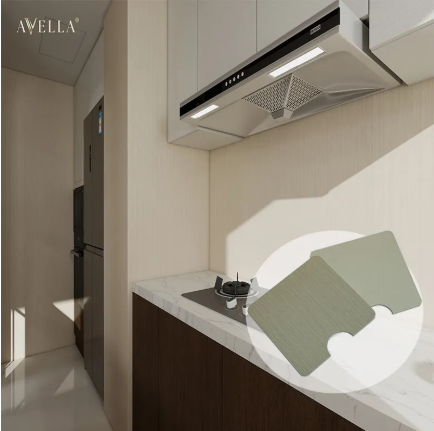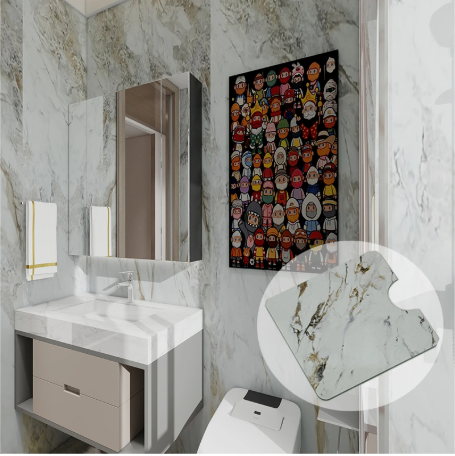-Core Technology SPC Wall Panel ສໍາລັບການປ້ອງກັນນ້ຳ
Closed-Cell PVC-Limestone Core Composition
ສິ່ງທີ່ເຮັດໃຫ້ແຜ່ນຜົນະໆ SPC ດີເລີດໃນການກັ້ນນ້ຳແມ່ນເທກໂນໂລຊີຂອງມັນ. ສ່ວນປະກອບຫຼັກແມ່ນ PVC ປິດເຊວລະອອງກັບຫີນປູນ ຊຶ່ງສ້າງເປັນວັດສະດຸທີ່ຄ້ອນຂ້າງແຂງແຮງສຳລັບບໍລິເວນທີ່ຄວາມຊື້ນມັກຈະເກີດຂຶ້ນເປັນປະຈຳ ເຊັ່ນ: ຫ້ອງນ້ຳ ຫຼື ຫ້ອງຄົວທີ່ຄວາມຊື້ນເປັນບັນຫາຕະຫຼອດເວລາ. ລັກສະນະການສ້າງຂອງແຜ່ນຜົນະໆເຫຼົ່ານີ້ເຮັດໃຫ້ນ້ຳຖືກກັ້ນໄວ້ພາຍນອກເນື່ອງຈາກເຊວທີ່ປິດໄວ້ຈະຈັບຄວາມຊື້ນໄວ້ກ່ອນທີ່ມັນຈະເຂົ້າໄປໃນວັດສະດຸ. ການອອກແບບນີ້ໃຫ້ທັງຄວາມເຂັ້ມແຂງແລະຄວາມຍືດຫຍຸ່ນໂດຍບໍ່ຫັກ, ສະນັ້ນແຜ່ນຈຶ່ງຕ້ານທານຕໍ່ຄວາມເສຍຫາຍໄດ້ດີເຖິງແມ່ນວ່າຈະມີຄວາມຊື້ນສູງ. ຜູ້ຜະລິດຄວບຄຸມປະລິມານວັດສະດຸໃນການຜະລິດຢ່າງລະມັດລະວັງ ແລະ ປັບຄວາມໜາແໜ້ນເພື່ອໃຫ້ແນ່ໃຈວ່າແຜ່ນຜົນະໆເຫຼົ່ານີ້ຈະບໍ່ບິດ ຫຼື ສູນເສຍຮູບຊົງຫຼັງຈາກຖືກນ້ຳຕະກອຍມາເປັນເວລາຫຼາຍປີ.
ແຜ່ນປິດຄະແນນປ້ອງກັນນ້ຳຈາກການເຂົ້າ
ໂຄງສ້າງເຊລລູແບບປິດທີ່ພົບເຫັນໃນແຜ່ນຜະນັງ SPC ສ້າງການປ້ອງກັນທີ່ມີປະສິດທິພາບຕໍ່ການລົ້ນຂອງນ້ຳ, ສຳເລັດການຊຶມຂອງຄວາມຊື້ນເຂົ້າໃນວັດສະດຸ ແລະ ກໍເຮັດໃຫ້ມັນເສື່ອມສະພາບໄປຕະຫຼອດເວລາ. ການທົດສອບກ່ຽວກັບວັດສະດຸໃນແບບດຽວກັນສະແດງໃຫ້ເຫັນວ່າພວກມັນສາມາດດູດຊຶມຄວາມຊື້ນໄດ້ພຽງ 0.1%, ສິ່ງທີ່ດີເລີດຫຼາຍໃນການພິຈາລະນາຈຳນວນນ້ຳທີ່ພວກມັນຕ້ອງປະເຊີນໃນສະພາບແວດລ້ອມທີ່ມີຄວາມຊື້ນ. ການເບິ່ງໃນສິ່ງທີ່ເກີດຂື້ນພາຍໃນແຜ່ນເຫຼົ່ານີ້ຈະອະທິບາຍເຫດຜົນທີ່ພວກມັນເຮັດວຽກໄດ້ດີໃນການຢຸດເຊົາຄວາມເສຍຫາຍຈາກນ້ຳ, ຮັບປະກັນວ່າສິ່ງທີ່ຕິດຕັ້ງຢູ່ຈະຍັງຄົງແຂງແຮງໄປຕະຫຼອດ. ໂຄງສ້າງທີ່ແຂງແຮງເຫຼົ່ານີ້ແມ່ນເຫດຜົນທີ່ແຜ່ນ SPC ດຳເນີນໄດ້ດີໃນສະຖານທີ່ທີ່ຄວາມຊື້ນເປັນບັນຫາຕະຫຼອດເວລາ, ກຳແພງຫ້ອງນ້ຳ ຫຼື ກຳແພງຫຼັງເຄົ້າເຕີທີ່ມີນ້ຳ splashes ເກີດຂື້ນຕະຫຼອດມື້.
ຜົນການຂອງ Core ຂົງສູງຕໍ່ຄວາມຕ້ອງການນ້ຳຫວານ
ຄວາມໜາແ້ນຂອງຊັ້ນໃນມີບົດບາດສຳຄັນໃນການຕ້ານທານຄວາມຊື້ນຂອງແຜ່ນຜົນຝາປະເພດ SPC. ແຜ່ນທີ່ມີຄວາມໜາແ້ນຂອງຊັ້ນໃນສູງກວ່າຈະມີຄວາມທົນທານດີກວ່າໃນດ້ານໂຄງສ້າງ. ມັນບໍ່ງໍອັນເນື່ອງຈາກຄວາມຊື້ນໄດ້ງ່າຍ, ສະນັ້ນຈຶ່ງຮັກສາລັກສະນະໃຫ້ສວຍງາມໄດ້ດົນກວ່າ. ການທົດສອບໄດ້ສະແດງໃຫ້ເຫັນວ່າແຜ່ນທີ່ມີຄວາມໜາແ້ນສູງມີປະສິດທິພາບດີກ່ວາແຜ່ນທີ່ມີນ້ຳໜັກເບົາໃນການຈັດການກັບບັນຫາຄວາມຊື້ນ. ສິ່ງທີ່ເຮັດໃຫ້ວັດສະດຸຄວາມໜາແ້ນສູງແຕກຕ່າງອອກມາຄືຄວາມສາມາດຂອງມັນໃນການຕ້ານທານທັງຄວາມກົດດັນ ແລະ ສະພາບທີ່ຊຸ່ມເປີ້ຍໃນເວລາດຽວກັນ. ສະນັ້ນມັນຈຶ່ງເໝາະສົມກັບບ່ອນທີ່ຖືກໃຊ້ງານຕະຫຼອດເວລາໃນສະພາບທີ່ມີຄວາມຊື້ນເຊັ່ນ: ໂຮງຄົວຮ້ານອາຫານ ແລະ ຫ້ອງນ້ຳສາທາລະນະ. ການຮັກສາຄວາມສະອາດ ແລະ ລັກສະນະທີ່ແໜ້ນໜາເປັນສິ່ງສຳຄັນຫຼາຍໃນບ່ອນເຊິ່ງຮູບຮ່າງພາຍນອກມີຄວາມສຳຄັນ.
บทบาทของเคลือบผิวต้านเชื้อรา
ພາແວນ SPC ຫຼາຍແບບມີຊັ້ນສີຕ້ານເຊື້ອເຫຼົ້າທີ່ຊ່ວຍຮັກສາຄວາມສະອາດ ແລະ ສຸຂະພາບໃນສະຖານທີ່ທີ່ມີຄວາມຊຸ່ມຊື່ນຫຼາຍ. ຊັ້ນສີເຫຼົ່ານີ້ສາມາດຢຸດເຊົາການເຕີບໂຕຂອງເຊື້ອເຫຼົ້າ ແລະ ຝຸ່ນເຊື້ອໄດ້, ສິ່ງທີ່ສໍາຄັນຫຼາຍໃນຫ້ອງນ້ໍາຍ້ອນວ່າພວກມັນມັກຈະປຽກຈາກການໃຊ້ງານປະຈໍາວັນ. ການຄົ້ນຄວ້າຊີ້ໃຫ້ເຫັນວ່າເມື່ອພາແວນມີຊັ້ນສີເຫຼົ່ານີ້, ພວກມັນສາມາດຕ້ານຈຸລິນຊີໄດ້ດີ, ອາດມີປະສິດທິພາບປະມານ 95-98% ຕາມຜົນການທົດສອບບາງຢ່າງ. ການປ້ອງກັນແບບນີ້ເຮັດໃຫ້ຄວາມແຕກຕ່າງໃນການສ້າງສະພາບການດໍາລົງຊີວິດທີ່ປອດໄພຫຼາຍຂຶ້ນ, ໂດຍສະເພາະສໍາລັບຄົນທີ່ກັງວົນກ່ຽວກັບພະຍາດພົ້ນເມົາ ຫຼື ບັນຫາກ່ຽວກັບລະບົບຫາຍໃຈໃນບັນດາບ່ອນທີ່ມີຄວາມຊຸ່ມຊື່ນ ໜ້າຫຼັກ .
ການປັບປຸງນ້ຳຫຼາຍແລະການກັບກົງກັບຫຼາຍ
ແຜ່ນ SPC ມາພ້ອມກັບຊິ້ນສ່ວນປ້ອງກັນນ້ຳທີ່ມີຄວາມສະເພາະທີ່ຊ່ວຍບໍ່ໃຫ້ນ້ຳເຂົ້າໄປໄດ້ ແລະ ປ້ອງກັນການເຕີບໂຕຂອງເຊື້ອເຫັດ. ຊ່າງຕິດຕັ້ງສ່ວນຫຼາຍຮູ້ດີວ່າ ການປິດຜນຶກແໜ້ນໃຫ້ຖືກຕ້ອງໃນສ່ວນຂອງແຂ້ນ ແລະ ຂໍ້ໂຕ້ ຈະເຮັດໃຫ້ຜົນຕ່າງກັນຫຼາຍເວລາປະຕິບັດກັບບ່ອນທີ່ມີຄວາມຊື່ນ. ເມື່ອສ່ວນທີ່ອ່ອນໄຫວເຫຼົ່ານີ້ຖືກປິດຜນຶກແໜ້ນຢ່າງຖືກຕ້ອງ ມັນຈະສ້າງເປັນເສັ້ນປ້ອງກັນທີ່ແຂງແຮງຕ້ານທານກັບຄວາມຊື່ນທີ່ເຂົ້າມາຈາກຫຼາຍທິດທາງ. ສິ່ງນີ້ຈະຊ່ວຍບໍ່ໃຫ້ເຊື້ອເຫັດເຕີບໂຕ ໃນຂະນະທີ່ຮັກສາຄວາມສາມາດໃນການຮັບນ້ຳໜັກ ແລະ ຄວາມງາມຂອງໂຄງສ້າງໄວ້ໄດ້ໃນໄລຍະຍາວ. ດ້ວຍເຫດຸນີ້ແຜ່ນຈຶ່ງມີອາຍຸການໃຊ້ງານຍາວນານກ່ວາເກົ່າ ເຖິງແມ່ນວ່າຈະຖືກໃຊ້ໃນສະພາບທີ່ມີນ້ຳຕະຫຼອດເວລາຫຼາຍປີ.
ຄວາມສັງເສີນໃນການລົງລູ້ແລະຫ້າງຫຼາ
ແຜ່ນ SPC ດຳເນີນການໄດ້ດີໃນສະຖານທີ່ທີ່ມີຄວາມຊຸ່ມຊື່ນຫຼາຍ, ກຳມະນິໄລຍ໌ຫ້ອງນ້ຳທີ່ມີກິ່ນເຫືອງຈາກການອາບນ້ຳຮ້ອນ ຫຼື ຫ້ອງຊັກຟອກໃນການຄ້າ. ຜູ້ທີ່ຕິດຕັ້ງແຜ່ນເຫຼົ່ານີ້ລາຍງານວ່າແຜ່ນຍັງຮັກສາຮູບລັກສະນະໃຫ້ເບິ່ງດີຢູ່ເຖິງແມ້ນວ່າຈະຖືກສຳຜັດກັບສະພາບແວດລ້ອມທີ່ຊຸ່ມເປືອກມາຫຼາຍປີ, ນັ້ນແມ່ນເຫດົດຜູ້ຄົນຈຶ່ງເລືອກໃຊ້ແຜ່ນນີ້ຫຼາຍກ່ວາວັດສະດຸທົ່ວໄປສຳລັບພື້ນທີ່ທີ່ມັກຈະປຽກຊຸ່ມ. ການທົດສອບໃນໄລຍະຫຼາຍປີສະແດງໃຫ້ເຫັນວ່າແຜ່ນ SPC ມີອາຍຸການໃຊ້ງານຍາວນານກ່ວາທາງເລືອກອື່ນໆໃນຂະນະທີ່ຮັກສາຮູບລັກສະນະດັ້ງເດີມໄວ້. ມັນບໍ່ເຄື່ອງບິດ ຫຼື ສີເຟືອຍເຊັ່ນກັບຜະລິດຕະພັນອື່ນໆເມື່ອຖືກສຳຜັດກັບກ້ອນນ້ຳ ແລະ ແອ້ວະຍະນະນ້ຳຕະຫຼອດເວລາ.
ຄວາມຕ້ອງການການແປງຮູບໃນການປ່ຽນແປງຄວາມຊຸມຊູມແວວ
ແຜ່ນຝາ SPC ສາມາດຕ້ານທານການບິດງໍໄດ້ດີເມື່ອລະດັບຄວາມຊື້ນຂຶ້ນລົງເລື້ອຍໆ ແລະ ສາມາດຮັກສາຮູບຊົງ ແລະ ຄຸນນະພາບໃນການໃຊ້ງານໄດ້ດົນນານ. ວັດສະດຸສ້າງສິ່ງອື່ນໆມັກຈະເກີດການບິດງໍເມື່ອຖືກສຳຜັດກັບຄວາມຊື້ນທີ່ປ່ຽນແປງຢ່າງໄວວານ ເຊິ່ງສົ່ງຜົນກະທົບຕໍ່ລັກສະນະ ແລະ ຄຸນນະພາບໃນການໃຊ້ງານໃນໄລຍະຍາວ. ແຕກຕ່າງຈາກວັດສະດຸເຫຼົ່ານັ້ນ ແຜ່ນ SPC ສາມາດຮັກສາຄວາມເຂັ້ມແຂງ ແລະ ຄວາມໝັ້ນຄົງໄດ້ດີ. ມັນເໝາະສົມກັບການຕິດຕັ້ງໃນບັນດາບໍລິເວນທີ່ມີບັນຫາຄວາມຊື້ນເປັນປະຈຳເຊັ່ນ: ຊັ້ນລົ່ນ ຫຼື ບໍລິເວນໃກ້ສະລອຍນ້ຳ ທີ່ຄວາມຊື້ນອາດຈະປາກົດຂຶ້ນ ແລະ ຫາຍໄປຢ່າງໄວວາຕະຫຼອດມື້.
ຄວາມສະຫງົບຂອງ SPC vs. ຕົວແທນການເປັນແມ່ນ
ແຜ່ນ SPC ຖືກອອກແບບມາເພື່ອຮັບມືກັບການປ່ຽນແປງຂອງອຸນຫະພູມໄດ້ດີກ່ວາທາງເລືອກອື່ນໆໃນຕະຫຼາດ. ເມື່ອອຸນຫະພູມເພີ່ມຂຶ້ນ ຫຼື ຫຼຸດລົງ, ແຜ່ນເຫຼົ່ານີ້ບໍ່ມີການຂະຫຍາຍຕົວ ຫຼື ຫຼຸດລົງຫຼາຍເຊັ່ນດຽວກັບວັດສະດຸໄມ້ ຫຼື ແຜ່ນ laminate ທຳມະດາ. ການສຶກສາຈາກຜູ້ຜະລິດຕ່າງໆໄດ້ຊີ້ໃຫ້ເຫັນວ່າ SPC ສາມາດຮັກສາຮູບຮ່າງໄດ້ດີເຖິງແມ້ກະທັ້ງໃນສະພາບອາກາດທີ່ຮຸນແຮງທີ່ເກີດຂຶ້ນເປັນຄັ້ງຄາວ. ຜູ້ຕິດຕັ້ງມັກຄຸນສົມບັດນີ້ຍ້ອນວ່າມັນຫມາຍເຖິງບັນຫາໜ້ອຍລົງກັບການບິດງໍ ຫຼື ຊ່ອງຫວ່າງທີ່ເກີດຂຶ້ນລະຫວ່າງແຜ່ນຕະຫຼອດເວລາ. ສຳລັບອາຄານທີ່ຕັ້ງຢູ່ໃນເຂດທີ່ອຸນຫະພູມປ່ຽນແປງເປັນປະຈຳໃນແຕ່ລະປີ, ຄວາມໝັ້ນຄົງຂອງແຜ່ນປະເພດນີ້ຈະເປັນປະໂຫຍດໃນໄລຍະຍາວ. ແຜ່ນຈະຍັງຄົງປະຕິບັດໜ້າທີ່ໄດ້ດີໂດຍບໍ່ຕ້ອງບຳລຸງຮັກສາ ຫຼື ແທນທີ່ຢ່າງຕໍ່ເນື່ອງ.

ຄວາມສັ້ນຍາວໃນສະຖານທີ່ຊຸມ
ສິ່ງໜຶ່ງທີ່ເດັ່ນຂອງແຜ່ນ SPC ແມ່ນການຮັກສາຄວາມເງິບໄວ້ໄດ້ດົນນານ, ເຖິງແມ່ນຕິດຕັ້ງໃນບັນດາເຂດທີ່ມີຄວາມຊຸ່ມ ຫຼື ຖືກໃຊ້ງານເປັນປະຈຳ. ການທົດສອບສະແດງໃຫ້ເຫັນວ່າ ແຜ່ນຜົນະສາມາດຕ້ານການບິດງໍ ແລະ ການບິດເບືອນໄດ້ດີກ່ວາທາງເລືອກດັ້ງເດີມຫຼາຍ, ບາງຄັ້ງສາມາດຢູ່ໄດ້ຫຼາຍປີໂດຍບໍ່ມີສາຍພິການເສຍຫາຍຈາກຄວາມຊຸ່ມ. ການຮັກສາພື້ນຜິວໃຫ້ເງິບໄວ້ມີຄວາມສຳຄັນຫຼາຍທັງໃນດ້ານທັດສະນະ ແລະ ການໃຊ້ງານ, ໂດຍສະເພາະໃນຫ້ອງນ້ຳ, ຫ້ອງຄົວ ຫຼື ຫ້ອງອື່ນໆທີ່ນ້ຳມັກຈະຄ້ັງຢູ່. ແຜ່ນພຽງແຕ່ຍັງຮັກສາຮູບລັກສະນະໃຫ້ດີໃນຂະນະທີ່ປະຕິບັດໜ້າທີ່ໄດ້ຢ່າງຖືກຕ້ອງພາຍໃນສະພາບການທີ່ຈະເຮັດໃຫ້ວັດສະດຸລາຄາຖືກກ່ວາບິດເບືອນໄປ
Snug Click-Lock Seam Technology
ການລັອກແບບຄລິກແມ່ນສຳຄັນຫຼາຍໃນການເຊື່ອມໂຍງແຜ່ນຝາ SPC ເຂົ້າກັນໂດຍບໍ່ໃຫ້ມີຊ່ອງຫວ່າງ ເຊິ່ງເຮັດໃຫ້ການຕິດຕັ້ງໄວຂຶ້ນ ແລະ ປ້ອງກັນນ້ຳຈາກການເຂົ້າໄປພາຍໃນ. ວິທີດັ້ງເດີມໃນການຕິດຕັ້ງແຜ່ນມັກຈະອີງໃສ່ກາວທີ່ເຢິ່ງທີ່ເຮັດໃຫ້ສິ່ງຕ່າງໆເປື້ອນ ຫຼື ການເຊື່ອມແບບລິ້ນແລະຮ່ອງດັ້ງເດີມທີ່ບໍ່ສາມາດຕ້ານທານຕໍ່ຄວາມເສຍຫາຍຈາກນ້ຳໄດ້ດີເທົ່າທີ່ຄວນ. ຕາມການທົດສອບໃນສະພາບແວດລ້ອມຈິງທີ່ຜູ້ຜະລິດຫຼາຍຄົນໄດ້ດຳເນີນມາ, ການເຊື່ອມໂຍງທີ່ຖືກປິດຜນຶກດີຈະຊ່ວຍຫຼຸດບັນຫາທີ່ເກີດຈາກຄວາມຊຸ່ມຊື່ນ ແລະ ຍືດເວລາການໃຊ້ງານຂອງແຜ່ນອອກໄປກ່ອນທີ່ຈະຕ້ອງປ່ຽນໃໝ່. ສຳລັບຜູ້ທີ່ເຮັດວຽກໃນບັນດາພື້ນທີ່ທີ່ຄວາມຊື່ນເປັນບັນຫາ ເຊັ່ນ: ຫ້ອງນ້ຳ ຫຼື ຫ້ອງຄົວ ລະບົບການລັອກແບບກົນຈະຊ່ວຍໃຫ້ຜູ້ໃຊ້ມີຄວາມສະຫງົບໃຈ ເນື່ອງຈາກຮູ້ວ່າຝາຈະຍັງຄົງແຫ້ງ ແລະ ສະພາບດີໄປຕະຫຼອດເວລາ.
กลยุทธ์การป้องกันการแทรกซึมของท่อน้ำเล็ก
ຄວາມຊຸ່ມຊື່ນທີ່ເຂົ້າໄປໃນພະນັງຜົນຜ່ານຮ່ອງນ້ອຍໆ ແມ່ນບັນຫາທີ່ແທ້ຈິງສຳລັບການຕິດຕັ້ງແຜ່ນພະນັງ, ໂດຍສະເພາະໃນການດູດຊຶມຄວາມຊຸ່ມຊື່ນທີ່ບໍ່ຕ້ອງການ. ແຜ່ນພະນັງ SPC ຈັດການບັນຫານີ້ໂດຍກົງກັນຂ້າມດ້ວຍວິທີແກ້ໄຂທາງວິສະວະກຳທີ່ສະຫຼາດຫຼາຍ. ແຜ່ນພະນັງມີລັກສະນະເຊັ່ນ: ກົມມົນທີ່ເຊື້ອງຂ້າງ ແລະ ພື້ນຜິວທີ່ເປັນເມັດທີ່ແທ້ຈິງຊ່ວຍຢຸດການນ້ຳໄຫຼເຂົ້າມາ. ການສຶກສາພົບວ່າການອອກແບບເຫຼົ່ານີ້ເຮັດວຽກໄດ້ດີຕໍ່ກັບການດູດຊຶມນ້ຳ, ທຳໃຫ້ແຜ່ນພະນັງມີອາຍຸຍືນຫຼາຍເຖິງແມ້ນວ່າຖືກສຳຜັດກັບຄວາມຊຸ່ມຊື່ນຕະຫຼອດເວລາ. ຜູ້ຮັບເໝົາທີ່ຕິດຕັ້ງແຜ່ນພະນັງເຫຼົ່ານີ້ລາຍງານບັນຫາໜ້ອຍລົງກ່ຽວກັບເຊື້ອເຫຼົ່າ ແລະ ການບິດງໍເມື່ອເວລາຜ່ານໄປ, ສິ່ງນີ້ເຮັດໃຫ້ເຂົ້າໃຈໄດ້ວ່າການກັ້ນນ້ຳທາງດ້ານຮ່າງກາຍມີປະສິດທິພາບຫຼາຍ. ສຳລັບຜູ້ທີ່ຈັດການກັບເຂດທີ່ມີຄວາມຊຸ່ມຊື່ນສູງ, ລັກສະນະການປ້ອງກັນເຫຼົ່ານີ້ໝາຍເຖິງຄວາມສະຫງົບໃຈທີ່ຮູ້ວ່າພະນັງຂອງເຂົາເຈົ້າຈະບໍ່ຖືກທຳລາຍຈາກບັນຫາຄວາມຊຸ່ມຊື່ນທີ່ຊ້ຳເຮົາໃນອະນາຄົດ.
ຄວາມສຳຄັນຂອງການປັບປຸງແຈ້ງແຕ່
ການຮັກສາຊ່ອງປິດຜນຂອບໃຫ້ຢູ່ໃນສະພາບດີ ມີຄວາມສຳຄັນຫຼາຍຕໍ່ການຮັບປະກັນວ່າແຜ່ນ SPC ສາມາດກັນນ້ຳໄດ້ຕະຫຼອດການໃຊ້ງານ. ເມື່ອຄົນພາດຂັ້ນຕອນການບຳລຸງຮັກສານີ້ ນ້ຳມັກຈະຊຶມເຂົ້າມາທາງຂອບ ສົ່ງຜົນໃຫ້ແຜ່ນພາຍໃນເນົ່າເປື່ອຍ ແລະ ຈົບລົງດ້ວຍຄ່າໃຊ້ຈ່າຍທີ່ສູງຫຼວງຫຼາຍໃນອະນາຄົດ. ຜູ້ຊ່ຽວຊານໃນອຸດສາຫະກຳສ່ວນຫຼາຍຈະບອກທຸກຄົນທີ່ສົນໃຈວ່າ ການກວດເຊັກຊ່ອງປິດຜນຂອບທຸກໆສອງສາມເດືອນ ແລະ ທຳການປັບປຸງໃໝ່ເມື່ອຈຳເປັນ ສາມາດປ່ຽນແປງທຸກຢ່າງໄດ້. ຜູ້ຈັດການສິ່ງອຳນວຍຄວາມສະດວກເຂົ້າໃຈເລື່ອງນີ້ດີ ເນື່ອງຈາກພວກເຂົາໄດ້ເຫັນຜົນຂອງການລໍຖ້າເກີນໄປ. ພໍ່ແມ່ເຮືອນຄວນສັງເກດເຊັ່ນກັນ ເນື່ອງຈາກຊ່ອງປິດຜນຂອບທີ່ຖືກບຳລຸງຮັກສາຢ່າງຖືກຕ້ອງບໍ່ພຽງແຕ່ຊ່ວຍກັນນ້ຳໄດ້ ແຕ່ຍັງຊ່ວຍຮັກສາຮູບລັກສນະຂອງຝາໃຫ້ຍັງຄົງດີໄວ້ຕະຫຼອດເວລາ. ບໍ່ມີໃຜຢາກໃຊ້ເງິນເພີ່ມເຕີມເພື່ອແກ້ໄຂບັນຫາທີ່ສາມາດປ້ອງກັນໄດ້ດ້ວຍການກວດສອບຢ່າງງ່າຍດາຍເປັນປະຈຳ.
SPC vs. ຕຳຫຼວງເซຣາມິກໃນເຂດນ້ຳ
ພື້ນເຊີແຊມິກໄດ້ຖືກຕິດຕັ້ງໃນບັນດາເຂດທີ່ມີນ້ຳມາດົນນານ, ແຕ່ແທນທີ່ຈະເປັນພື້ນແບບ SPC ກັບມີບາງປະໂຫຍດດີໆ ທີ່ຄວນເອົາໃຈໃສ່. ກ່ອນອື່ນໝົດ, ແຜ່ນພື້ນປະເພດນີ້ງ່າຍຕໍ່ການຕິດຕັ້ງຫຼາຍຂຶ້ນຍ້ອນມີນ້ຳໜັກເບົາກ່ວາພື້ນເຊີແຊມິກຫຼາຍ, ສະນັ້ນບໍ່ຈຳເປັນຕ້ອງໃຊ້ເຄື່ອງມືໜັກໆ ຫຼື ຄົນຊ່ວຍຈາກພະນັກງານຕິດຕັ້ງເພີ່ມເຕີມ. ອີກປະໂຫຍດໜຶ່ງແມ່ນຄວາມອົບອຸ່ນຂອງມັນເມື່ອປຽບທຽບກັບພື້ນເຊີແຊມິກທີ່ສາມາດເຢັນຈົນເຈັບປຸ້ຍໃນລະດູໜາວ. ການທົດສອບຕ່າງໆໄດ້ສະແດງໃຫ້ເຫັນຊ້ຳແລ້ວຊ້ຳອີກວ່າແຜ່ນພື້ນ SPC ສາມາດຕ້ານທານຕໍ່ຄວາມຊຸ່ມເປີເປີໄດ້ດີຂຶ້ນ, ໂດຍບໍ່ແຕກເຊັ່ນທີ່ເຊີແຊມິກເຄີຍເປັນຫຼັງຈາກຖືກໃຊ້ມາດົນນານຈາກການຂະຫຍາຍ ແລະ ຫົດໂຕຍ້ອນການປ່ຽນແປງຂອງອຸນຫະພູມ. ດ້ວຍເຫດຸຜົນທັງໝົດນີ້, ບັນດາຜູ້ຮັບເໝົາຈຶ່ງມັກໃຊ້ແຜ່ນພື້ນ SPC ໃນຫ້ອງນ້ຳ ແລະ ຫ້ອງຄົວເຊິ່ງເປັນບ່ອນທີ່ຄວາມສະດວກສະບາຍມີຄວາມສຳຄັນ ແລະ ຕ້ອງການວັດສະດຸທີ່ສາມາດຢູ່ໄດ້ຍາວນານຕໍ່ການສຳຜັດກັບນ້ຳຕະຫຼອດເວລາ.
ຄວາມໜັງຄ້າແລະຄວາມສຳເລັດໃນການຕິດຕັ້ງ
ການເບິ່ງຕົວເລກສະແດງໃຫ້ເຫັນເຖິງເຫດຜົນທີ່ພື້ນ SPC ມັກຈະມີຄ່າໃຊ້ຈ່າຍຕໍ່າກ່ວ່າໃນການຕິດຕັ້ງເມື່ອປຽບທຽບກັບທາງເລືອກອື່ນ. ພວກມັນບໍ່ຕ້ອງການປູນຊາຍ ຫຼື ເຄື່ອງມືທີ່ຊັບຊ້ອນຍ້ອນວ່າພະນັກງານພຽງແຕ່ຕ້ອງວັດແທກ, ຕັດ, ແລະ ສອດເຂົ້າກັນ. ວິທີການງ່າຍດາຍນີ້ຊ່ວຍຫຼຸດຜ່ອນຄວາມຕ້ອງການໃນການຈ້າງຊ່າງທີ່ມີຄ່າໃຊ້ຈ່າຍແພງ ແລະ ສຳເລັດວຽກໄດ້ໄວຂຶ້ນ, ຊຶ່ງຊ່ວຍປະຢັດເງິນໃນທຸກໆປະເພດໂຄງການຕັ້ງແຕ່ການປັບປຸງເຮືອນຂະໜາດນ້ອຍຈົນເຖິງການກໍ່ສ້າງທາງພາຄີ. ເມື່ອພວກເຮົາຄິດໄລ່ເຖິງຄວາມຄຸ້ມຄ່າຂອງພື້ນແຕ່ລະແຜ່ນໃນໄລຍະຍາວເມື່ອປຽບທຽບກັບລາຄາເບື້ອງຕົ້ນ, ພວກເຮົາສາມາດເຫັນໄດ້ຢ່າງຈະແຈ້ງເຖິງຄຸນຄ່າຂອງມັນ. ເມື່ອປຽບທຽບກັບວິທີກັນນ້ຳແບບດັ້ງເດີມເຊັ່ນ: ຜ້າໄວນິນ ຫຼື ແຜ່ນເຊີແມິກ, ພື້ນ SPC ສະໜອງຄວາມຄຸ້ມຄ່າໃນການລົງທຶນໂດຍບໍ່ຕ້ອງແລກເຊີນຄຸນນະພາບ
ຄວາມແຂງແຮງ ດຶ່ງທີ່ມີຄວາມສົມບູນ
ແຜ່ນ SPC ຖືກສ້າງຂຶ້ນເພື່ອໃຫ້ຢືນຢານໄດ້ດົນກ່ວາໄມ້ທຳມະຊາດ ຫຼື ວັດສະດຸປະສົມເມື່ອຖືກໃຊ້ໃນບັນດາບ່ອນທີ່ມີຄວາມຊຸ່ມຊື່ນ. ການຄົ້ນຄວ້າຊີ້ໃຫ້ເຫັນວ່າໂດຍທົ່ວໄປແລ້ວມັນສາມາດຢືນຢານໄດ້ດົນກ່ວາ 10 ປີ ເມື່ອທຽບໃສ່ທາງເລືອກອື່ນໆໃນສະພາບແວດລ້ອມທີ່ມີຄວາມຊຸ່ມຊື່ນ, ສະນັ້ນຈຶ່ງໝາຍເຖິງການປ່ຽນແທນໜ້ອຍລົງໃນໄລຍະຍາວ ແລະ ການປະຢັດເງິນໃນການບຳລຸງຮັກສາ. ອາຍຸການໃຊ້ງານທີ່ຍາວນານຂຶ້ນເຮັດໃຫ້ມັນມີຄຸນຄ່າດີໃນການລົງທຶນສຳລັບໂຄງການກໍ່ສ້າງຕ່າງໆ, ໂດຍສະເພາະໃນກໍລະນີທີ່ງົບປະມານມີຂອບເຂດຈຳກັດ. ການເລືອກໃຊ້ແຜ່ນ SPC ຈະຊ່ວຍໃຫ້ອາຄານມີການປ້ອງກັນຄວາມເສຍຫາຍຈາກນ້ຳໄດ້ດີຂຶ້ນໃນຂະນະທີ່ຍັງສາມາດຄວບຄຸມຄ່າໃຊ້ຈ່າຍໃຫ້ຕ່ຳໄວ້ໄດ້ໃນໄລຍະຍາວ.
ການ chùiລ້າວທຸກໆວັນເພື່ອຕ້ອງກັບຄວາມຊຸມແລະຄວາມຊຸມ
ການຮັກສາຄວາມງາມຂອງແຜ່ນຜົນຝາປະເພດ SPC ແລະ ຕ້ານທານຕໍ່ກັບການເປື້ອນ ຕ້ອງໃຊ້ການບຳລຸງຮັກສາພື້ນຖານບາງຢ່າງ. ການຂັດລ້າງເປັນປະຈຳຈະຊ່ວຍຮັກສາຄວາມງາມໄວ້ໄດ້ດົນນານ ແລະ ສາມາດໃຊ້ງານໄດ້ຢ່າງຖືກຕ້ອງ. ສ່ວນຫຼາຍແລ້ວຄົນມັກໃຊ້ນ້ຳຢາຂັດລ້າງທີ່ອ່ອນໂຍນເນື່ອງຈາກວ່ານ້ຳຢາທີ່ແຮງອາດເຮັດໃຫ້ພື້ນຜິວເສຍຫາຍໄດ້. ຄວນຊອກຫາຜະລິດຕະພັນທີ່ມີສະຫຼາກວ່າປອດໄພສຳລັບວັດສະດຸທີ່ລະອຽດ ເນື່ອງຈາກມັນສາມາດຕ້ານການເຕີບໂຕຂອງເຊື້ອເຫັດ ແລະ ຈຸດດຳທີ່ແກ້ໄຂຍາກໂດຍບໍ່ເຮັດໃຫ້ເກີດບັນຫາ. ສະຖານທີ່ທີ່ມີຄົນຍ່າງຜ່ານໄປມາຫຼາຍຄັ້ງຕ້ອງໃຫ້ຄວາມສຳເລັດເພີ່ມເຕີມ ເນື່ອງຈາກການຈາລະຈອນສາມາດສ້າງຄວາມເສຍຫາຍໄດ້ຫຼາຍຂຶ້ນ. ຖ້າພວກເຮົາປະຕິບັດຕາມວິທີການງ່າຍໆນີ້ໃນເວລາສ່ວນຫຼາຍ, ແຜ່ນ SPC ຂອງພວກເຮົາຄວນຈະຢູ່ໄດ້ດົນຂຶ້ນ ແລະ ຮັກສາຮູບຮ່າງໄວ້ໄດ້ຕະຫຼອດໄລຍະເວລາການໃຊ້ງານ.
ການປົກຄື່ມຸມອີກຄັ້ງເພື່ອການປ້ອງກັນຍາວວັນ
ການປິດຜນຂອງແຜ່ນ SPC ຢ່າງສະໝໍ່າສະເໝີຊ່ວຍບັນເຊົາຄວາມຊຸ່ມຊື່ນແລະປ້ອງກັນຄວາມເສຍຫາຍຕໍ່ໂຄງສ້າງ. ນັກຊ່ຽວຊານສ່ວນຫຼາຍແນະນຳໃຫ້ກວດເບິ່ງຜນປິດປາກເທດລະບ້ອນເຄື່ອງໃນບ່ອນທີ່ຄວາມຊຸ່ມຊື່ນສູງເຊັ່ນ: ໃກ້ເຂົ້າໃນເຮືອນຄົວ ຫຼື ຫ້ອງນ້ຳ. ເມື່ອປະຕິບັດຢ່າງຖືກຕ້ອງ, ການບຳລຸງຮັກສານີ້ຍັງຊ່ວຍຍືດອາຍຸການໃຊ້ງານຂອງແຜ່ນໄດ້ດົນຂຶ້ນກ່ອນທີ່ຈະຕ້ອງປ່ຽນໃໝ່ຍ້ອນວ່ານ້ຳຈະບໍ່ມີໂອກາດເຂົ້າໄປເຮັດໃຫ້ວັດສະດຸດ້ານໃຕ້ເນົ່າເສຍໄປ. ການດຳເນີນການນີ້ຍັງມີປະໂຫຍດຫຼາຍຢ່າງເຊັ່ນ: ແຜ່ນຈະຍັງຮັກສາຮູບລັກສະນະໄດ້ດີແທນທີ່ຈະບິດ ຫຼື ຈາງສີ ຊຶ່ງເປັນສິ່ງສຳຄັນທັງໃນດ້ານຄວາມງາມ ແລະ ການປະຕິບັດງານ. ບັນດາເຈົ້າຂອງເຮືອນທີ່ດຳເນີນການໃນຂັ້ນຕອນນີ້ມັກຈະພົບວ່າພວກເຂົາປະຢັດເງິນໄດ້ໃນໄລຍະຍາວ ເມື່ອທຽບໃສ່ກັບການຕ້ອງປ່ຽນແຜ່ນທັງໝົດຍ້ອນນ້ຳເສຍຫາຍ.
ການແກ້ໄຂຄວາມເສຍໃນເຂດທີ່ມີນ້ຳຫຼຸດຫຼາຍ
ຫ້ອງຄົວ ແລະ ຫ້ອງນ້ຳ ເຊິ່ງມີນ້ຳແຈ່ງຕະຫຼອດເວລາ ຈຳເປັນຕ້ອງໃຫ້ຄວາມສົນໃຈເປັນພິເສດ ເນື່ອງຈາກວ່າພວກມັນຖືກເຜຊີນໜ້າກັບຄວາມຊຸ່ມຊື່ນຫຼາຍກ່ວາສ່ວນອື່ນຂອງເຮືອນ. ການສັງເກດເບິ່ງວ່ານ້ຳຖືກຕີໃສ່ພື້ນຜິວເຫຼົ່ານີ້ເລື້ອຍປານໃດ ຈະຊ່ວຍໃຫ້ຮູ້ບັນຫາຕັ້ງແຕ່ຕົ້ນກຳເນີດ ກ່ອນທີ່ຈະກາຍເປັນບັນຫາໃຫຍ່ສຳລັບແຜ່ນພັນ. ພະນັກງານສ່ວນຫຼາຍແນະນຳໃຫ້ເພີ່ມຊັ້ນປ້ອງກັນເພີ່ມເຕີມໃນບັນດາຈຸດທີ່ມີນ້ຳແຈ່ງເພື່ອໃຫ້ພື້ນທີ່ເຫຼົ່ານັ້ນຕ້ານທານຕໍ່ການເສຍຫາຍຈາກນ້ຳໄດ້ດີຂຶ້ນ. ເມື່ອດຳເນີນການຢ່າງຖືກຕ້ອງ ການບຳລຸງຮັກສາປະເພດນີ້ຈະຊ່ວຍໃຫ້ແຜ່ນພັນເຮັດວຽກໄດ້ດີຕະຫຼອດໄລຍະຍາວ ແລະ ຍັງຊ່ວຍຮັກສາຮູບຮ່າງໃຫ້ຍັງຄົງສວຍງາມເປັນເວລາດົນນານ ເຖິງແມ່ນວ່າຈະມີນ້ຳເປັນອັນຕະລາຍຕະຫຼອດເວລາກໍຕາມ. ການໃຫ້ຄວາມສົນໃຈໃກ້ຊິດກັບບັນດາຈຸດສຽງຕໍ່ການເສື່ອມສະພາບ ຈະຊ່ວຍປ້ອງກັນການເສື່ອມສະພາບຢ່າງຊ້າໆ ແລະ ຮັກສາຄຸນຄ່າຂອງແຜ່ນພັນທີ່ເຮັດໃຫ້ພວກມັນຄຸ້ມຄ່າໃນການໃຊ້ງານ.
ຄຳຖາມທີ່ພົບເລື້ອຍ
ສິ່ງທີ່ເຮັດໃຫ້ພຸດທະສະພາບ SPC ຄົບຄ້າງຕໍ່ນ້ຳແມ່ນຫຍັງ?
ພຸດທະສະພາບ SPC ມີຄຸນສຳພາດຕໍ່ນ້ຳເນື່ອງຈາກມີສ່ວນປະສົມຂອງ PVC ແລະ ລິມູ້ນສູນທີ່ຫຼຸດຄວາມຮັບກັບນ້ຳແລະກັບຄັກນ້ຳ.
SPC panels ການປ້ອງກັນຫຼາຍແລະຫຼາຍແມ່ນແນວໃດ?
ພານ SPC ໄດ້ຖືກປະສົມດ້ວຍເນື້ອໝາກທີ່ຕ້ອງກັບຄວາມຊຸມຊູມ ເພື່ອຫຼຸດລົງການເຮັດໃຫ້ເກີດຫຼາຍຂຶ້ນ ແລະມີການປິດປົກຂັ້ນສູງ ເພື່ອປ້ອງກັນນ້ຳເຂົ້າ, ສຳເລັດໃນການປິດລົງຄວາມສະอาດໃນແຂວງການທີ່ມີຄວາມຊຸມສູງ.
ພານ SPC ເປັນຫຼາຍກວ່າປະເທດໄຄ້່ງໃນເຂດທີ່ມີນ້ຳຫຼີນບໍ່?
ແມ່ນ, ພານ SPC ໄດ້ມາກວ່າໃນການປະຕິບັດຄວາມອຸ່ນແລະສະຫຼັບສະຫຼາຍກວ່າປະເທດໄຄ້່ງ, ເຮັດໃຫ້ມັນເປັນສິ່ງທີ່ເປັນຫຼາຍກວ່າສຳລັບເຂດທີ່ມີນ້ຳຫຼີນ.
ຂ້ານຳເປັນຫຼາຍກວ່າທີ່ຈະຕ້ອງການການແກ້ວໄຂ້ພານ SPC?
ແມ່ນແຫ່ງກັບການກວດສອບແລະປິດປົກຄັ້ງໃໝ່ຂອງພານ SPC ອັນນຸ່ນ, ຕົວຢ່າງເປັນພິເສໃນເຂດທີ່ມີຄວາມຊຸມສູງ, ເພື່ອປິດລົງຄວາມສຳເລັດຂອງນ້ຳ.
ພານ SPC ໄດ້ສາມາດຕ້ອງກັບການປ່ຽນແປງຄວາມຊຸມໄວໄດ້ບໍ່?
ແມ່ນ, ພານ SPC ດຳເນີນການອອກແບບເພື່ອຕ້ອງກັບການຍົນແລະສຳເລັດໃນການປິດລົງຄວາມສະຖິຕິ, ໂດຍມີການປ່ຽນແປງຄວາມຊຸມໄວ.
ສາລະບານ
-
-Core Technology SPC Wall Panel ສໍາລັບການປ້ອງກັນນ້ຳ
- Closed-Cell PVC-Limestone Core Composition
- ແຜ່ນປິດຄະແນນປ້ອງກັນນ້ຳຈາກການເຂົ້າ
- ຜົນການຂອງ Core ຂົງສູງຕໍ່ຄວາມຕ້ອງການນ້ຳຫວານ
- บทบาทของเคลือบผิวต้านเชื้อรา
- ການປັບປຸງນ້ຳຫຼາຍແລະການກັບກົງກັບຫຼາຍ
- ຄວາມສັງເສີນໃນການລົງລູ້ແລະຫ້າງຫຼາ
- ຄວາມຕ້ອງການການແປງຮູບໃນການປ່ຽນແປງຄວາມຊຸມຊູມແວວ
- ຄວາມສະຫງົບຂອງ SPC vs. ຕົວແທນການເປັນແມ່ນ
- ຄວາມສັ້ນຍາວໃນສະຖານທີ່ຊຸມ
- Snug Click-Lock Seam Technology
- กลยุทธ์การป้องกันการแทรกซึมของท่อน้ำเล็ก
- ຄວາມສຳຄັນຂອງການປັບປຸງແຈ້ງແຕ່
- SPC vs. ຕຳຫຼວງເซຣາມິກໃນເຂດນ້ຳ
- ຄວາມໜັງຄ້າແລະຄວາມສຳເລັດໃນການຕິດຕັ້ງ
- ຄວາມແຂງແຮງ ດຶ່ງທີ່ມີຄວາມສົມບູນ
- ການ chùiລ້າວທຸກໆວັນເພື່ອຕ້ອງກັບຄວາມຊຸມແລະຄວາມຊຸມ
- ການປົກຄື່ມຸມອີກຄັ້ງເພື່ອການປ້ອງກັນຍາວວັນ
- ການແກ້ໄຂຄວາມເສຍໃນເຂດທີ່ມີນ້ຳຫຼຸດຫຼາຍ
- ຄຳຖາມທີ່ພົບເລື້ອຍ

